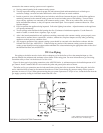
21
AWI/TWI Control System – Sequence of Operation
(Refer to Figures 16 or 17 for ladder and connection diagrams)
Sequence of Operation, Standing Pilot
1) When the boiler is energized, 24 volts is immediately applied to terminals “1” (blue) and “4” (yellow) on the vent damper.
Assuming that there is no call for heat, and that the damper switch is in the “automatic” position, the damper will close.
2) A call for heat from the thermostat energizes relay coil 1R (the relay on the L8148E), causing contacts 1R1 and 1R2 to
make. Contact 1R1 starts the circulator. Contact 1R2 sends power to the high limit.
3) Assuming that the high limit is made, current will flow to pin terminal #2 (orange) at the vent damper and the damper will
open.
4) Once the vent damper is fully open, an end switch inside the damper will make, energizing pin #3 (red) at the damper. This
pin is connected through the damper harness to terminal “B1” on the L8148E. At this point in the operating sequence, 24
volts is present across “B1” and “B2”.
5) Under normal conditions, the flame roll-out switch and blocked vent switch are made. Voltage will therefore immediately
appear across the combination gas control (“gas valve”) terminals “TH” and “TR”.
6) When the boiler is first placed into operation, the pilot must be lit. The pilot heats a thermocouple which generates a small
amount of electricity sufficient to hold open the safety shut-off valve in the combination gas control. The circuit connecting
the thermocouple and the safety shut-off valve is self contained and completely independent of all other wiring on the boiler.
This safety shut-off valve is upstream of the 24 volt valves in the gas control which open in response to a call for heat. If the
pilot is not lit, the safety shut-off valve will remain closed and gas will not reach the 24 volt valves.
7) Assuming that the pilot is established and proven by the thermocouple, the application of 24 volts across the combination
gas valve terminals energizes the redundant 24 volt solenoid valves in the combination gas control, resulting in gas flow
through the control and burner operation.
FIGURE 19: ZONE WIRING USING HONEYWELL V8043F ZONE VALVES
(FACTORY WIRING NOT SHOWN - SEE FIGURE 16 OR 17)
19


















